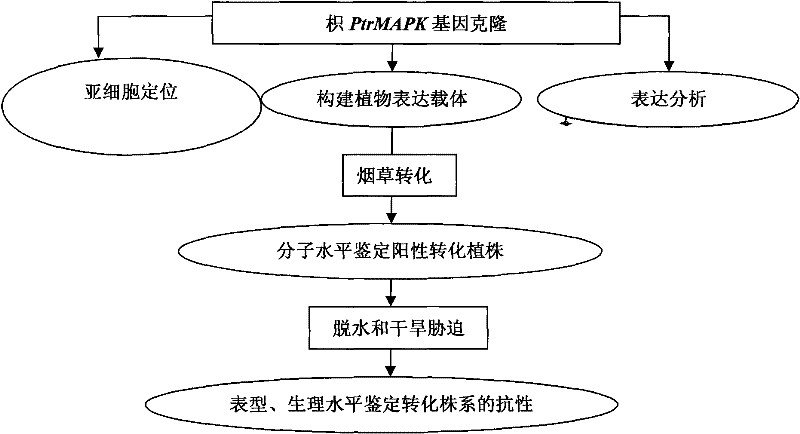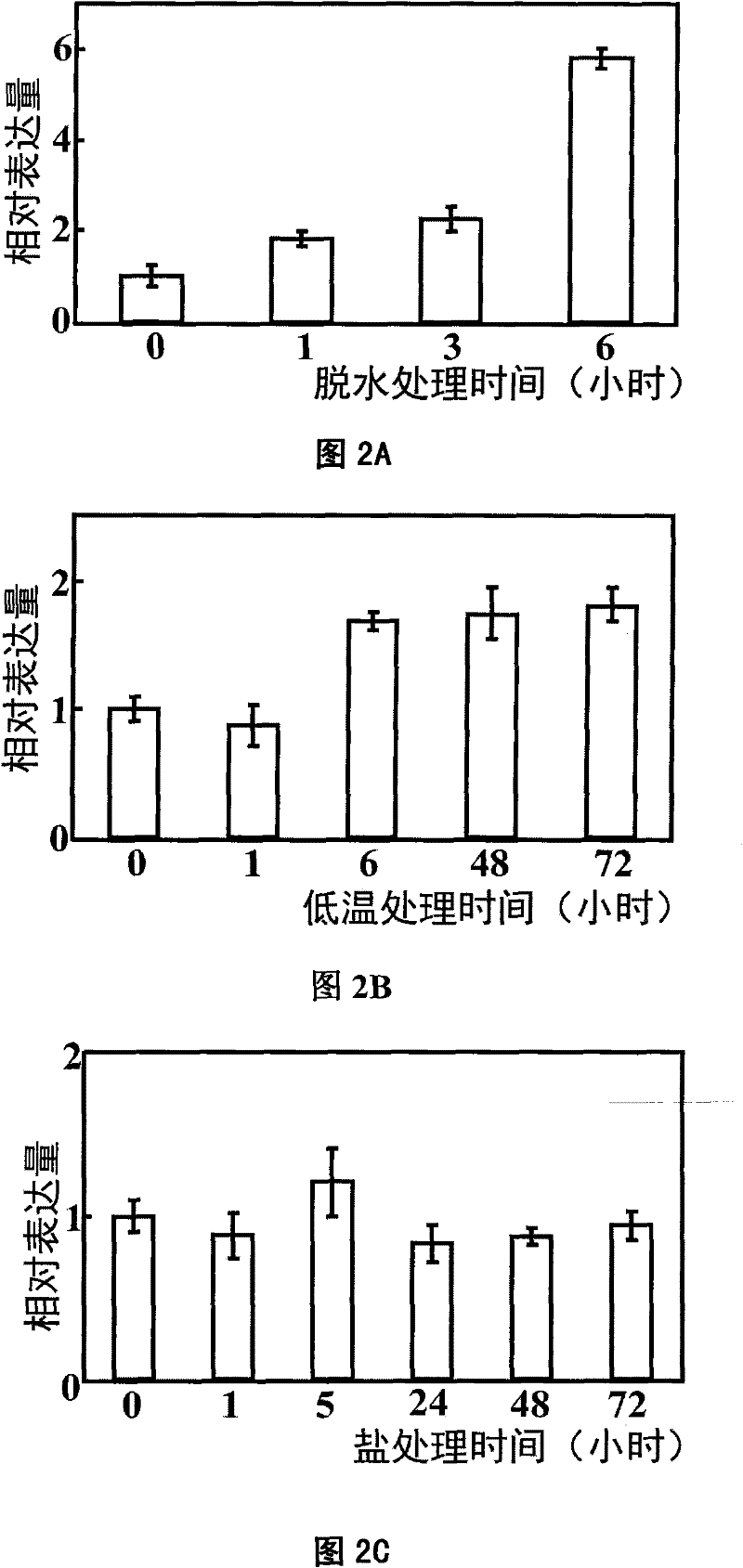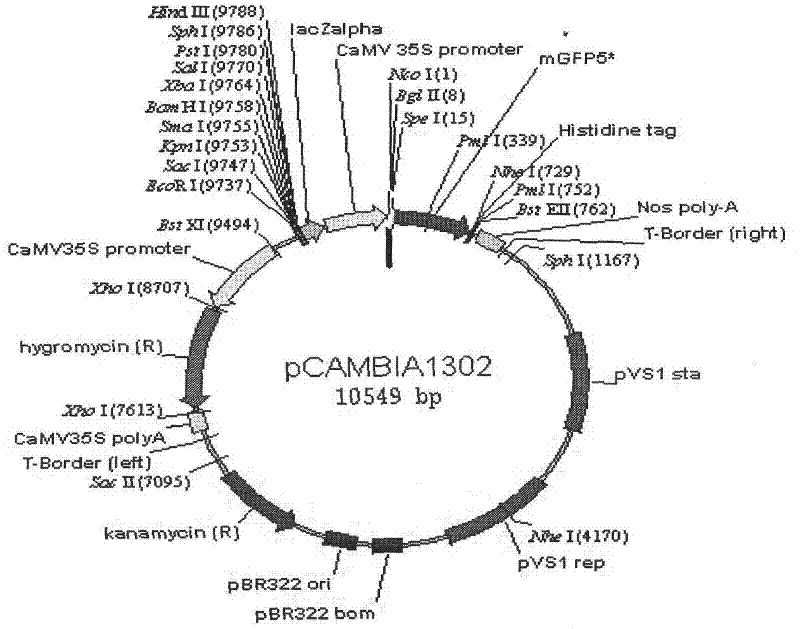Cloning of poncirustrifoliata mitogen-activated protein kinase (PtrMAPK) and application of PtrMAPK to improvement of drought resistance of plant
A gene and plant technology, applied in plant products, genetic engineering, plant genetic improvement, etc., can solve problems such as no drought resistance, protein kinase function to be further verified, no gene cloning and functional verification reports, etc.
- Summary
- Abstract
- Description
- Claims
- Application Information
AI Technical Summary
Problems solved by technology
Method used
Image
Examples
Embodiment 1
[0027] Embodiment 1, PtrMAPK gene isolation cloning and expression analysis
[0028] Search the citrus EST database (HarvEST: Citrus ver.0.51) with MAPK as the keyword, and get 7 similar sequences. These are composed of DNAstar (public software) to form a unigene, and the sequence analysis software (ORF Finder) finds that the gene MAPK lacks the 5-end For the coding sequence, a complete ORF sequence was amplified using the 5'RACE kit (Clontech, PaloAlto, CA, USA), and the primer GSP1 (GSP, 5'-CCACACATCTATTGCAGCAGTGTAGTCAG-3') was designed with Primer Premier 5.0 for the sequence, and RT -PCR method to amplify the 5-terminal sequence. The amplified 5-terminal sequence and the existing MAPK unigene were overlapped into a sequence using the software DNAstar. RNA was extracted and reverse-transcribed from leaves of Hovenia trifoliata under dehydration at 25°C, and the obtained first-strand cDNA was used to amplify the full-length PtrMAPK gene. RNA was extracted using a Trizol ki...
Embodiment 2
[0030] Example 2, PtrMAPK gene subcellular localization
[0031] In this example, onion epidermis was used to study the subcellular localization of PtrMAPK gene. The entire ORF of the PtrMAPK gene was amplified by RT-PCR, and two restriction sites of NcoI and SpeI were added at both ends of the amplification primer. First, the amplified product is loaded on the pMD18-T vector to obtain a pMD18-T N / S -PtrMAPK recombinant vector. Simultaneously use NcoI and SpeI to cut PMD18-T N / S - PtrMAPK and pCAMBIA1302 (see image 3 ), the product was recovered and ligated to construct a recombinant vector, thereby obtaining the pCAMBIA1302-PtrMAPK-GFP recombinant vector. After confirming that the sequence is correct, heat shock the pCAMBIA1302-PtrMAPK-GFP recombinant vector and the control vector (pCAMBIA1302) (reference: Sam Brook, translated by Huang Peitang, "Molecular Cloning Experiment Manual" third edition, Science Press, 2002) Transformed into Agrobacterium EHA105 respectively. ...
Embodiment 3
[0032] Embodiment 3, plant transformation vector construction
[0033] According to the multiple cloning site of the pMV vector (in the plant binary transformation vector pBI121 with GUS gene excised, donated by Professor Ye Zhibiao, School of Horticulture and Forestry, Huazhong Agricultural University) and the sequence of the coding region of the PtrMAPK gene, primers were designed according to the general principles with Primer Premier 5.0 The software designs the upstream and downstream PCR primers for amplifying the entire coding region of the PtrMAPK gene (the pair of primers is the pair of primers for amplifying the cDNA sequence of the PtrMAPK gene of the present invention). Its sequence is as follows:
[0034] Forward primer: 5’-CG GTC GAC GGAGAGAGAGTAAAATGGCTGACG-3'
[0035] Reverse primer: 5’-AA GGTACC GAAAGATTGTCGGCCACCTGCAG-3'
[0036] The clone of PtrMAPK gene was used as template for PCR amplification. The annealing temperature for PCR amplification was 60°...
PUM
 Login to View More
Login to View More Abstract
Description
Claims
Application Information
 Login to View More
Login to View More - R&D
- Intellectual Property
- Life Sciences
- Materials
- Tech Scout
- Unparalleled Data Quality
- Higher Quality Content
- 60% Fewer Hallucinations
Browse by: Latest US Patents, China's latest patents, Technical Efficacy Thesaurus, Application Domain, Technology Topic, Popular Technical Reports.
© 2025 PatSnap. All rights reserved.Legal|Privacy policy|Modern Slavery Act Transparency Statement|Sitemap|About US| Contact US: help@patsnap.com



